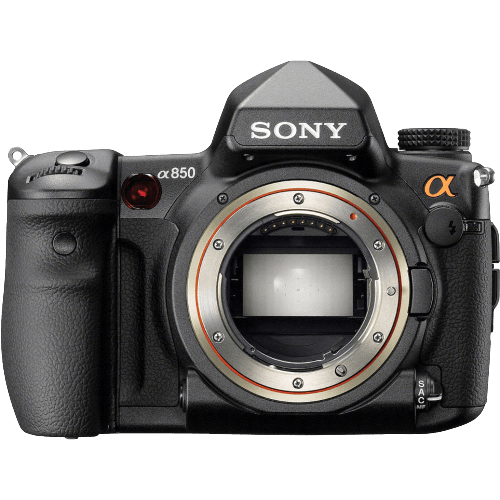Sony Alpha 850 Specs and Scores

The Sony Alpha 850 receives a score of 55/100 for its general specifications. Announced on August 27, 2009, this DSLR camera was released at a launch price of $2000. Measuring 156 x 117 x 82mm and weighing 895g (1.97lbs), it’s a modestly sized and weighted camera for its time. However, in today’s market, these specifications may not be as competitive, considering advancements in technology and design. The Sony Alpha 850 still has its merits, but newer models have surpassed its capabilities.
Sony Alpha 850 Overview and Optics
The optics of the Sony Alpha 850 receive a score of 65/100. With 24.6 megapixels, a shooting speed of 3 frames per second, and a CMOS sensor, the camera delivers decent performance. The Bionz processor and a DXOMARK sensor score of 79 contribute to the overall quality. The full-frame sensor size, Sony Alpha lens mount, image stabilization, and 3:2 aspect ratio are additional factors to consider.
Comparing the Sony Alpha 850 to today’s market, the camera shows its age, especially in terms of shooting speed and sensor performance. Modern cameras tend to have higher megapixels, faster shooting speeds, and improved processors. However, the full-frame sensor and image stabilization features of the Alpha 850 remain relevant and desirable.
The Sony Alpha 850 offers satisfactory optics for casual photographers, but those seeking top-of-the-line performance might find it lacking compared to newer models.
Sony Alpha 850 Video Performance
The Sony Alpha 850 lacks video capabilities. This camera focuses on photography only.
Sony Alpha 850 Features and Benefits
The Sony Alpha 850 feature score stands at 28/100, which might seem low, but let’s examine the specifications to understand how it competes in today’s market. The camera has a 3-inch screen, with a resolution of 921,600 dots, providing clear and crisp image previews. However, the Alpha 850 lacks a touchscreen, which is a common feature in modern cameras.
The camera does have a flip screen, offering flexibility in shooting angles. Despite this, the Alpha 850 misses essential connectivity features such as GPS, WiFi, and Bluetooth, which are now standard in most cameras. These missing features limit the camera’s compatibility with other devices and hinder the user’s ability to share and transfer files seamlessly.
Considering the specifications, the Sony Alpha 850 has some useful features, but it falls short in terms of connectivity and user convenience. While it may appeal to those seeking a simple camera with a flip screen, the absence of modern features makes it less competitive in today’s market.
Sony Alpha 850 Storage and Battery
The Sony Alpha 850’s storage and battery receive a score of 71/100. This camera has two memory card slots, accepting Compact Flash (Type I or II), UDMA, Memory Stick Duo, and Pro Duo cards. While offering multiple card options, it does not support the newer and faster SDXC cards, which could limit storage capacity and transfer speeds.
The Alpha 850 uses an NP-FM500H battery, providing 880 shots per charge. This battery life is adequate for most photography sessions, but falls short compared to the latest cameras with longer battery life. Additionally, the camera lacks USB charging, making it less convenient for on-the-go charging.
Considering these factors, the Sony Alpha 850’s storage and battery capabilities are satisfactory but not exceptional in today’s market.
